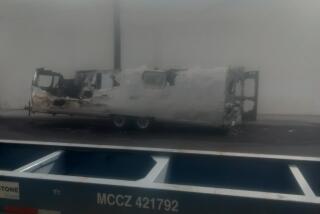Richard Whitcomb dies at 88; engineer’s discoveries changed design of jets
Richard Whitcomb, a mechanical engineer who changed the way we fly today with three design innovations that made airplanes fly farther and faster using less fuel, has died. He was 88.
Whitcomb died of pneumonia Tuesday in Newport News, Va.
His contributions, for which he won the most prestigious prize in aviation, focused on a plane’s efficiency cutting through air at speeds approaching the sound barrier, or the “transonic region.” As airplanes approach the speed of sound, they encounter a significant increase in drag, or force that resists the plane’s movement through the air.
Whitcomb made improvements to wings and how they attach to the fuselage to lessen the amount of drag on an airplane.
“His intellectual fingerprints are evident on virtually every commercial aircraft flying today,” said Tom Crouch, senior curator of aeronautics at the National Air and Space Museum. He called Whitcomb one of the most important aeronautical engineers since the end of World War II.
As a young, obscure engineer in 1951 with a NASA predecessor, the Hampton, Va.-based National Advisory Committee for Aeronautics, Whitcomb made a discovery so simple yet so radical that it forever changed jet design.
Until Whitcomb’s improvement, the bodies of most jet airplanes were cigar shaped to be sleek, as with Chuck Yeager’s squat, orange Bell X-1 experimental craft. The X-1 easily broke the sound barrier, but it was impractical for tactical use -- it was a hot rod built for one purpose. The Air Force wanted fighter planes that could maneuver supersonically with ease and greater capability.
Whitcomb developed a body design that allowed jet planes to travel faster than ever using the same engine and same amount of fuel: the “Coke-bottle” shape, otherwise known as a “wasp waist.”
To make up for the drag that the surface area of the wings created, the answer was simple: Cut it out. By pinching the fuselage at the section where the wings connected, the drag they had created was neutralized.
His innovation became known as the area rule, and, at 34, Whitcomb was awarded the National Aeronautic Assn.’s Collier Trophy for the greatest achievement in aviation in 1954. Previous recipients included aviation pioneers including Glenn H. Curtiss, Howard Hughes, Glenn L. Martin, Elmer A. Sperry and Chuck Yeager.
In addition to the Collier Trophy, Whitcomb received the National Medal of Science, the nation’s highest honor for science and engineering, in 1973. He also was inducted into the National Inventors Hall of Fame and National Academy of Engineering.
Whitcomb, who admitted that he was not math-minded, used his imagination as a wind tunnel. Colleagues said he could “see air.”
“Most people have to see through testing how air moves on a model,” said Roy Harris, former aeronautics director at the Hampton facility, who worked with Whitcomb for decades. “But he had this uncanny ability to accurately sense how air molecules reacted over a surface before he even built the models.”
With Whitcomb’s aeronautic improvements, new Air Force fighter jets sailed through the sound barrier and kept going, sometimes adding as much as 100 mph to their top speeds.
Whitcomb also broke through a barrier as a researcher.
His innovation earned him unprecedented carte blanche and the freedom to design as he pleased.
Richard Travis Whitcomb was born Feb. 21, 1921, in Evanston, Ill., and grew up in Worcester, Mass. His father, who had flown balloons in World War I, was an engineer. As a young man, Richard Whitcomb used his parents’ basement to improve model planes he bought.
In 1943, he graduated from Worcester Polytechnic Institute with a bachelor’s degree in mechanical engineering.
He had read about the National Advisory Committee for Aeronautics laboratory in Langley, Va., in an article in Fortune magazine and, suitably impressed, applied and got a job there as a researcher helping to design the B-29 bomber.
After inventing the “area rule” slim-waist design, Whitcomb made two improvements to wing design that furthered the efficiency of airplanes traveling in the transonic region.
Planes encounter fierce resistance as they near the sound barrier, like speed boats over choppy water. In 1969, Whitcomb designed a wing that eliminated that resistance with a thick, blunt leading edge, a flat top, a bulging underside and a tail edge that hooked downward with a lip that looked like an extended flap.
The resulting design, called the “supercritical wing,” is incorporated in almost every commercial airliner flying today, and has saved the industry billions in dollars in fuel costs and flying time, Crouch and Harris said.
Whitcomb also designed small wings attached to the tips of wings at inclined angles. These winglets, as he called them, diffuse small vortexes on the wingtips that create significant drag on a plane. Despite the winglets’ diminutive design, they increase fuel efficiency as much as 6% to 7%.
Whitcomb, a longtime resident of Hampton, never married and is survived by a sister. His fellow researchers called him a workaholic. He often would work a double shift, take a short nap on a cot he had next to the wind tunnel where he tested, and then go right back.
Whitcomb officially retired in 1980 but continued to work as a consultant for NASA and other aerospace companies. But Whitcomb did not work for money and had little use for it. He used expired checks, sometimes almost a year old, as bookmarks.
“There’s been a continual drive in me ever since I was a teenager to find a better way to do everything,” Whitcomb told the Washington Post in 1969. “A lot of very intelligent people are willing to adapt, but only to a certain extent. If a human mind can figure out a better way to do something, let’s do it. I can’t just sit around. I have to think.”
Shapiro writes for the Washington Post.
More to Read
Start your day right
Sign up for Essential California for news, features and recommendations from the L.A. Times and beyond in your inbox six days a week.
You may occasionally receive promotional content from the Los Angeles Times.






